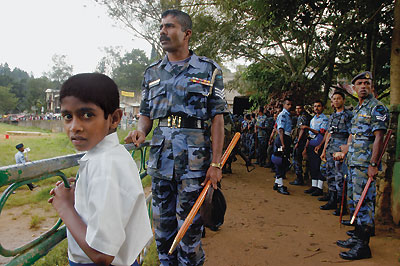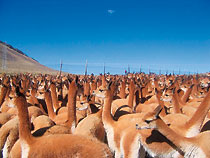Ends of a Campaign
In late June, as The Campaign for Bates neared the finish line, Allison Caine ’07 was on a bus in Peru approaching a goal of her own. Thousands of miles separated Caine’s destination, a wildlife preserve, from the Bates staffers sweating out the campaign’s final days. But their goal and Caine’s were inextricably linked.

The multifaceted Barlow Endowment supports campus exhibits of study-abroad photos. Jeremy Fisher ’06 photographed this boy watching air force training in Sri Lanka.
An environmental studies major, Caine based her senior thesis on the vicuña, an animal with valuable wool and a potent symbolic role in the culture and economy of the Andes. The bus was bringing this Maine native to the International Vicuña Festival, which would provide a narrative framework for her thesis.
Caine immersed herself in the festival, which celebrates the species’ rescue from extinction and its place in the traditional culture. She interviewed participants and took part in the “chaccu,” a shearing ritual that doesn’t hurt the vicuñas but does raise good money for local development. “I was part of the 2.5-kilometer-long human chain corralling the vicuñas,” Caine says — one of hundreds of people who walked miles through the scrub with a rope, decorated with ribbons, that they used to herd the llama-like animals.

Caine was able to attend the festival because six years ago, in the first year of The Campaign for Bates, David Barlow ’79 gave $1.5 million to establish the Barlow Endowment for Study Abroad. A Barlow grant paid her travel costs from Ecuador, where she studied for six months, to Peru. No grant, no festival, Caine says.
She’s a good example of the real differences that the campaign is making. Totaling nearly $121 million, about a million above its stated goal, the campaign will have countless such practical, essential impacts that form the foundation for academic excellence. These range all the way up to scholarship funds that grew by $23.5 million and to a surge of faculty resources — four new named professorships, more dollars for research and sabbaticals, and pay raises that are moving Bates into the ballpark with its peers.
A Bates Trustee, Barlow was inspired to make the gift after reflecting on his own study-abroad experiences in Europe and North Africa. The transcendental moment during his travels came one night in Egypt, as he perched on a pyramid at Giza and marveled at a sound-and-light show. Travel then and since has left him “actively seeking exposure to new cultures, new ways of looking at things, and then embracing those aspects that resonate,” Barlow says. He wanted to share that awareness with a greater number of Bates students — as well as faculty, who use Barlow funds to scout study-abroad sites, and alums who teach at the K–12 level.
Bates’ approach to study abroad is distinguished by its emphasis on individualized attention. The Barlow program supports that by helping students connect their travels with their academic work, explains Steve Sawyer, the dean in charge of study-abroad programs. When extra money will help a student reach an objective — whether the money pays for plane fare, an extended stay at the study-abroad site, or supplemental thesis research back at Bates — Barlow funds are there. In fiscal year 2006, the endowment allocated nearly $53,000 for 57 projects (plus an annual campus exhibition of photographs, including the one opening this article, taken by students during their time abroad.)
As for Caine, her sound-and-light moment came on the bus. In all her time in South America, she hadn’t seen a live vicuña. But finally, through the bus window on that day in June, Caine saw her first vicuñas running through a field. “It was a very powerful experience,” she recalls. “They were so beautiful and graceful, and I just got teary.”